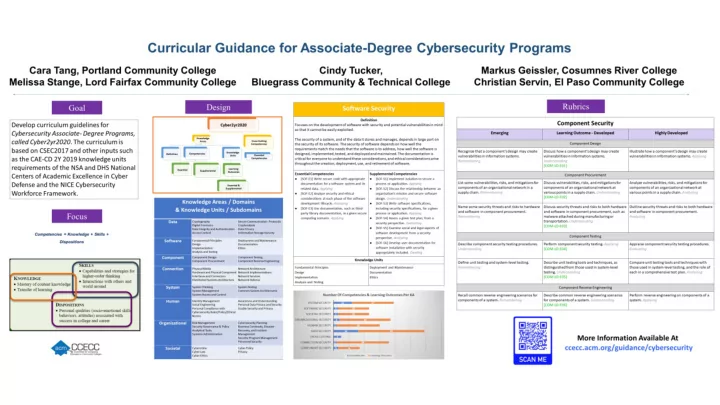

Curricular Guidance for Associate-Degree Cybersecurity Programs Cara Tang, Cindy Tucker, Markus Geissler, Portland Community College Bluegrass Community & Cosumnes River College Technical College Melissa Stange, Christian Servin, Lord Fairfax Community College El Paso Community College
Goal Develop curriculum guidelines for Cybersecurity Associate-Degree Programs, called Cyber2yr2020 . The curriculum is based on CSEC2017 and other inputs, such as the CAE-CD 2Y 2019 Knowledge Units requirements of the NSA and DHS National Centers of Academic Excellence in Cyber Defense, and the NICE Cybersecurity Workforce Framework.
Focus Competencies = Knowledge + Skills + Dispositions
Design Cyber2yr2020 Knowledge Cross-Cutting Areas Competencies Knowledge Competencies Definition Essential Units Competencies Learning Essential Supplemental Outcomes Essential & Supplemental
Knowledge Areas / Domains & Knowledge Units / Subdomains Data Cryptography Secure Communication Protocols Digital Forensics Cryptanalysis Data Integrity and Authentication Data Privacy Access Control Information Storage Security Software Fundamental Principles Deployment and Maintenance Design Documentation Implementation Ethics Analysis and Testing Component Component Design Component Testing Component Procurement Component Reverse Engineering Connection Physical Media Network Architecture Hardware and Physical Network Implementations Component Interfaces and Network Services Connectors Network Defense Distributed Systems Architecture System System Thinking System Testing System Management Common System Architectures System Access and Control Human Identity Management Awareness and Understanding Social Engineering Personal Data Privacy and Security Personal Compliance with Usable Security and Privacy Cybersecurity Rules/Policy/Ethical Norms Organizational Risk Management Cybersecurity Planning Security Governance & Policy Business Continuity, Disaster Analytical Tools Recovery, and Incident Systems Administration Management Security Program Management Personnel Security Societal Cybercrime Cyber Policy Cyber Law Privacy Cyber Ethics
Software Security Definition Focuses on the development of software with security and potential vulnerabilities in mind so that it cannot be easily exploited. The security of a system, and of the data it stores and manages, depends in large part on the security of its software. The security of software depends on how well the requirements match the needs that the software is to address, how well the software is designed, implemented, tested, and deployed and maintained. The documentation is critical for everyone to understand these considerations, and ethical considerations arise throughout the creation, deployment, use, and retirement of software. Essential Competencies Supplemental Competencies ● ● [SOF-E1] Write secure code with appropriate [SOF-S1] Implement isolation to secure a documentation for a software system and its process or application. Applying ● related data. Applying [SOF-S2] Discuss the relationship between an ● [SOF-E2] Analyze security and ethical organization’s mission and secure software considerations at each phase of the software design. Understanding ● development lifecycle. Analyzing [SOF-S3] Write software specifications, including ● [SOF-E3] Use documentation, such as third- security specifications, for a given process or party library documentation, in a given secure application. Applying ● computing scenario. Applying [SOF-S4] Assess a given test plan, from a security perspective. Evaluating ● [SOF-S5] Examine social and legal aspects of software development from a security perspective. Analyzing ● [SOF-S6] Develop user documentation for software installation with security appropriately included. Creating Knowledge Units Fundamental Principles Deployment and Maintenance Design Documentation Implementation Ethics Analysis and Testing
Number Of Competencies & Learning Outcomes Per KA SYSTEM SECURITY 12 27 SOFTWARE SECURITY 3 20 SOCIETAL SECURITY 3 20 ORGANIZATIONAL SECURITY 4 33 HUMAN SECURITY 2 28 DATA SECURITY 16 43 CROSS CUTTING 5 CONNECTION SECURITY 2 34 COMPONENT SECURITY 3 14 Competencies Learning Outcomes
Rubrics Component Security Emerging Learning Outcome - Developed Highly Developed Component Design Recognize that a component’s design may create Discuss how a component’s design may create Illustrate how a component’s design may create vulnerabilities in information systems. vulnerabilities in information systems. vulnerabilities in information systems. Applying Remembering Understanding [COM-LO-E01] Component Procurement List some vulnerabilities, risks, and mitigations for Discuss vulnerabilities, risks, and mitigations for Analyze vulnerabilities, risks, and mitigations for components of an organizational network in a components of an organizational network at components of an organizational network at supply chain. Remembering various points in a supply chain. Understanding various points in a supply chain. Analyzing [COM-LO-E02] Name some security threats and risks to hardware Discuss security threats and risks to both hardware Outline security threats and risks to both hardware and software in component procurement. and software in component procurement, such as and software in component procurement. Remembering malware attached during manufacturing or Analyzing transportation. Understanding [COM-LO-E03] Component Testing Describe component security testing procedures. Perform component security testing. Applying Appraise component security testing procedures. Understanding [COM-LO-E04] Evaluating Define unit testing and system-level testing. Describe unit testing tools and techniques, as Compare unit testing tools and techniques with Remembering distinguished from those used in system-level those used in system-level testing, and the role of testing. Understanding each in a comprehensive test plan. Analyzing [COM-LO-E05] Component Reverse Engineering Recall common reverse engineering scenarios for Describe common reverse engineering scenarios Perform reverse engineering on components of a components of a system. Remembering for components of a system. Understanding system. Applying [COM-LO-E06]
More information available at ccecc.acm.org/guidance/cybersecurity
Recommend
More recommend